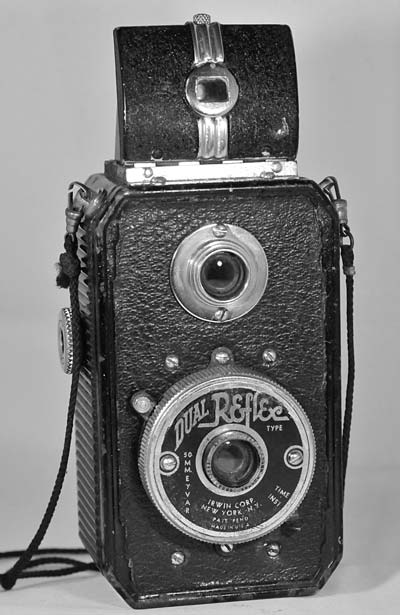Irwin Dual Reflex
Specification

| Manufacturer | : | Irwin Corporation, New York |
|---|---|---|
| Produced | : | 1939 - 1942 |
| Classification | : | Medium Format |
| Body Type | : | Pseudo Twin Lens Reflex |
| Construction | : | Bakelite/pressed steel |
| Film Type | : | 127 |
| Film Width | : | 46mm |
| Image Size | : | 1¼ x 1⅝ inch |
| No. of Images | : | 16 |
| Lens Type | : | Eyvar Meniscus |
| Focal Length | : | 50mm |
| Focus Type | : | Fixed |
| Focus Range | : | 6ft to inf, |
| Aperture Type | : | Fixed |
| Aperture | : | f/16 |
| Shutter Type | : | Rotary |
| Shutter Speeds | : | B, I*(1/60 sec) |
| Size Open (w x h x d) | : | 83 x 170 x 62 mm |
| Size Closed (w x h x d) | : | 83 x 135 x 62 mm |
| Weight | : | 416g |
| * Measured on this camera | ||
Art Deco Credentials
![]()
![]()
![]()
Noteworthy: Worth giving special attention
- Produced after the main Art Deco period;
- Bakelite body with pressed steel front and back;
- Polished chrome fittings;
- Art Deco lettering on nameplate;
- Triple rib detail on viewfinder cover;
- Ribbed detailing on sides;
- Simulated leather on front and back;
Description
The Irwin Dual Reflex is made with a Bakelite body with front and back made from pressed steel. It has a decorative Art Deco scripted faceplate. When the hood is opened, it reveals a ground glass viewfinder showing the whole of the image. The advantage of ground glass viewfinders is that no tilting is required to get the image centralised. The disadvantage is that they are usually not very bright. It also has a sports viewfinder found in the hood. It is sometimes called a pseudo twin lens reflex camera. It isn't a true TLR because the top lens is just part of the viewfinder and does not aid focussing
It takes 16 1¼ x 1⅝ (3 x 4.5 cm) inch images on 127 roll film. The Eyvar meniscus lens has an aperture of f/16 and the time/instant shutter has a speed of 1/60s.
The back is removable for loading, and has two red windows and a large retaining knob. It has a single tripod socket on the base.
How to Use
This camera takes 127 film which is still available from select outlets - search for 'Rera Pan 100-127' which is a black & white film. For those photographers in the UK, try Nick & Trick photographic services. If you want to use a particular type of film which is not available commercially, then you can cut your own 127 film from any 120 film. See my page on 'How to cut 127 film from 120 film'.
Remember to cover the two red windows except when winding on in low light. The film is advanced until the first frame number is seen in the bottom red window, and for the next frame, the film is advanced until the same frame number appears in the top window. Then it's back to the bottom window for the next frame.
If you don't want to bother with an exposure meter, follow the guide shown. It is based on the 'Sunny 16' rule. Film is so forgiving and will produce acceptable results even when overexposed by 2 or 3 stops or underexposed by 1 stop.
Remember that the exposure guide in the camera user manual may not be helpful as it is based on the use of old film with a low ISO value.
The table assumes that the sun is at least 30 degrees above the horizon - that's 10am - 5pm on a summer's day in the UK.
This camera has an aperture of f/16 and a shutter speed is 1/60s.
As the shutter speed is only 1/60s, it is advisable to use a tripod or to hold the camera against a wall or other solid object. For quick snapshots, hold it firmly against your body.
Using ISO 100/125 film - shutter speed 1/60s
| Weather Conditions | Shadow Detail | Aperture | Exposure |
|---|---|---|---|
 Sunny SunnySnow/Sand | Dark with sharp edges | f/16 | +2 Stop Overexposed Acceptable |
 Sunny Sunny | Distinct | f/16 | +1 Stop Overexposed Acceptable |
 Slight Overcast Slight Overcast | Soft around edges | f/16 | Good |
 Overcast Overcast | Barely visible | f/16 | -1 Stop Underexposed Acceptable |
 Heavy Overcast Heavy Overcast | None | f/16 | -2 Stop Underexposed Unacceptable |
 Open Shade Open Shade/Sunset | None | f/16 | -3 Stop Underexposed Unacceptable |